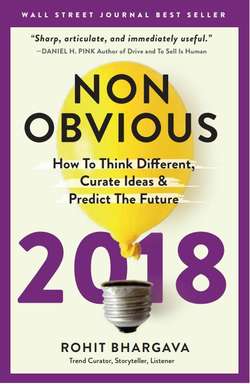Читать книгу Non-Obvious 2018 Edition - Рохит Бхаргава - Страница 12
На сайте Литреса книга снята с продажи.
The Underappreciated Side of Data
ОглавлениеNow, if you happen to be an analytical person, this process will hardly seem rigorous enough to be believable. How can collecting ideas and waiting possibly be a recipe for developing genuine insights? What about first-hand research, surveys, and focus groups? What about trend panels and using a global army of trend spotters? What about the data?
While it’s easy to assume that data means putting numbers into a spreadsheet or referencing some piece of analytics published in a journal—the truth is that data has a forgotten side that has little to do with devising experiments and far more to do with training your powers of observation.
When you think about the discipline that goes into scientific research to produce raw data, research can seem like a task only performed by robot-like perfectionists. The truth of scientific research, just like the truth behind many equally complex areas of study, is that experiments aren’t the only way to gather data—nor might they even be the most accurate.
Trends, like science, aren’t always perfectly measured phenomena that fit neatly into a spreadsheet without bias. Discovering trends takes a willingness to combine curiosity with observation and add insight to create valuable ideas that you can then test to ensure they are valid.
The one thing that I don’t believe describes this method is, ironically, the one term that comes to many people’s minds as soon as the art of predicting the future is mentioned: “trend spotting.” The term itself is a symbol of the biggest myths we tend to believe about those who predict or describe the future.
Let’s explore these myths and the reasons behind their popularity.
